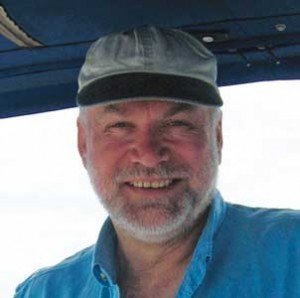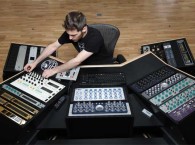
knowledge to open his own audio design
boutique, which he named Tortuga Audio.
SHANNON BECKER: Tell us about your company Tortuga Audio. Can you also share the story behind your sea turtle mascot?
MORTEN SISSENER: Tortuga Audio is a boutique audio design, manufacturing, and marketing company located in South Florida. At present we only sell through the Internet via our website although we expect to add channel partners in the future probably starting in Europe. We’re a little over a year old in terms of coming out with our first products—a line of passive preamplifiers built around light-dependent resistors (LDRs). We actually manufacture here in the US. While it may not hold much sway with customers, there’s something satisfying in being able to say “Made in the USA.” That’s the short and mostly dry of it.
Our mascot is the sea turtle wearing a set of headphones. People who know me wouldn’t describe me as being particularly religious or spiritual, but I’ve come to accept the sea turtle as my totem. A totem is an object or symbol representing an animal or plant that serves as an emblem of an individual, family, or tribe. You don’t pick your totem. Your totem picks you.
I’ve always had a fascination with a place called The Dry Tortugas. It’s a small cluster of islands about 70 miles west of Key West, FL. I first heard of this place in an adventure book I read when I was a young boy. I fell in love with reading, warm blue water, and The Dry Tortugas.
Years later, I bought a boat in South Florida. The first time I took that boat offshore I went out 20 miles, stopped, and turned off the engines. I was out of sight of land. The water was glassy calm. Thirty feet off the starboard beam a sea turtle surfaced and stared at me. I stared back. This lasted for over a minute. Then the turtle dove away. The name I’d already put across the transom of my boat was The “Tortuga Dreamer.” So when it came time to name my audio company you could say it named itself—Tortuga Audio.
SHANNON: What prompted you to start a company that designs and manufactures audio equipment, particularly in 2010 when the economy was so uncertain?
MORTEN: Starting an audio company that caters to a shrinking niche of audio fanatics as the masses continued shifting to low-resolution MP3 audio and inexpensive ear buds was arguably a questionable business decision. However, it was definitely a passionate business decision. Approaching 60, I figured it was time to pursue my passion rather than my resume. And I’ve always been passionate about technology, audio, and music. You could say the rational engineer decided to follow his heart.

SHANNON: What kind of audio products do you build? Can you share some of your design challenges?
MORTEN: While the business rationale behind the founding of Tortuga Audio may not win first prize in any business plan contest, the decision to pursue our flagship product was, and remains, highly rational and compelling.
Back in 2009, I was building a tube preamplifier mostly as an exercise to see if tubes could really offer more than solid state. I was less than impressed with the results even though I’d used a well recognized kit/design and top-of-the-line components.
At the time I was using a motorized Alps Blue Velvet potentiometer for volume control. Thinking that perhaps I could improve the sound by going to a stepped attenuator, I stumbled across LDRs. I cobbled together a very basic LDR volume control based on bits and snippets of information on the Internet, pulled out the Alps potentiometer and installed the LDR. The result was nothing less than a revelation!
The fact that this tube preamplifier went from disappointing to awesome simply by changing the attenuator made quite an impression on me and frankly I couldn’t stop thinking about it. It’s what engineers do. Especially this engineer. I can’t stop thinking of ways to do things differently or better. I’ve always hated that old saying, “if it ain’t broke, don’t fix it.” Can you imagine Steve Jobs saying that?
This led me to ask a simple question. Why do I need a preamplifier? Why preamplify and then amplify? Do I really need the additional gain? In most instances, the answer is no.
I looked at all the complexity of that tube preamplifier and decided to pull out the LDR attenuator, set the preamplifier aside, and use the LDR as a purely passive volume controller. The result? It sounded even better without the tube preamplifier. And not just a little bit better, a lot better! I was so impressed with this LDR attenuator that I couldn’t leave it alone. From that point forward, I dove into the deep end of LDR volume control.
SHANNON: What makes your audio equipment unique?
MORTEN: LDRs are challenging to work with because they are both nonlinear and variable. Nonlinear means their relationship between control signal applied to an LDR and the resulting resistance level is not a simple fixed ratio. Variable means that this nonlinear relationship can vary from one LDR to the next even with LDRs of the same model, from the same manufacturer, and from the same production run. That’s a lot of variable nonlinear stuff and that makes it very hard to get consistent predictable behavior when using LDRs for volume control. No designer likes to work with audio components that behave like LDRs.
Part of our solution to taming the wild LDR was to design a programmable digital control unit that enables us to control the analog LDR with proprietary software algorithms. We combine digital control with a two-step testing protocol such that each LDR preamplifier we build has a custom set of software-based correction curves that ensures predictable performance. This is neither simple nor easy, but we’ve put an enormous amount of time and effort into developing the software and hardware tools to do this cost effectively.
The result is a unique and game-changing LDR-based passive preamplifier (volume control) design that we believe rivals not only all other passive preamplifiers out there but also meets or beats even the best high-end active preamplifiers. While I happen to believe this personally, feedback from our customers and reviewers continues to reinforce this view.
SHANNON: Are you currently planning or working on any new product designs?
MORTEN: Our core focus continues to be advancing the development of our LDR-based volume controller products. In the third quarter of 2012, we came out with our LDR1 and LDR6 passive preamplifiers, which are finished preamplifier products. In the third quarter of 2013, we introduced the LDR3x passive preamplifier controller board (the LDR3x), which we marketed to the DIY audio community. We plan on continuing to serve the high-end audiophile consumers with finished products and provide DIY products to audio enthusiasts who’d rather build it themselves.
In November of 2013, we introduced the HiZ upgrade to our LDR-based preamplifiers. The HiZ algorithm enabled us to raise the input impedance of our LDRx products resulting in a remarkable improvement to an already fantastic-sounding preamplifier/volume controller. As far as we know, nobody else has done anything like this.
In terms of what’s next, we are working hard on coming out with our new line of LDRx passive preamplifiers including our new LDR3B, which I believe may be the first-ever LDR-based preamplifier for balanced audio. We hope to release the LDR3B before the end of March. Since we are a relatively low-volume business and want to offer distinctive products that are not priced out of reach to most audiophiles, we’ve decided to manufacture our own enclosures in-house going forward. This will keep our costs down while enabling us to offer high-quality products and still retain the flexibility of small-batch production, quick design changes, and the ability to offer custom solutions.
Beyond our next generation line of LDR preamplifiers, we plan to introduce a buffer companion product to our passive preamplifiers that will expand the application of our preamplifier/volume controller to include sources and amplifiers where a pure passive may not be the best fit. We are also considering the introduction of an integrated amplifier product that will allow us to target a broader market. These will be second half of 2014 products.
Longer term, we are quite excited about the prospects for an OEM version of our LDR preamplifier controller product. Every active preamplifier or integrated amplifier sold and marketed to the audiophile community that currently uses a potentiometer for volume control would sound better with a Tortuga Audio LDR volume controller. And along with being the best-sounding attenuator available, it also includes input switching, IR remote control, and a built-in encoder control.
SHANNON: How did you become interested in audio electronics?
MORTEN: As a newly minted mechanical engineer, I started my professional career in the aerospace sector working with complex electromechanical systems. This segued into energy when the company I was with in California became interested in alternative methods of power production. This eventually led me into industrial construction, large capital project development, project finance, software, sales and marketing, wind, solar and biofuels, as well as several start-ups along the way. An interesting ride but all along I was remained very interested in technology, software development, audio, and music. I decided it was time for my true interests to rule the day rather than the inertia of my resume. Plus I’m just an unapologetic techno-geek with a big creative itch that needed scratching. I also like to run my own show.
SHANNON: Where do you see the audio industry in 10 years?
MORTEN: I believe the high-end audiophile market with many components costing $10,00 or more is going to continue to decline into obscurity. Many have argued that the high-end market may already be in a terminal death spiral of rising prices and shrinking volume. I tend to agree. If true, that’s not a sustainable scenario for high-end audio.
The audio listening paradigm of a big-rig stereo in the living room that the aging baby boomer audiophiles were introduced to in the 1970s is not the central paradigm of contemporary audio. Where only a few years ago you could go into a big box store and see racks of receivers, rows of speakers and even a “high end” listening room, today, most of that is simply gone.
Ironically, we are collectively listening to more music from more sources more of the time than ever before. Access to music is wide if not deep. The Internet has become the new radio. Online streaming is becoming the norm for most consumers while buying and owning music is slowly retreating, This is especially true for physical media such as CDs.
Despite this bounty of access, we’ve also experienced the concurrent dumbing down of audio quality (e.g., low-resolution MP3 files) and listening through lo-fi hardware, most of which has gone mobile. So it’s an interesting mixed bag of good and bad news for us audio nutters.
While the road ahead may be unclear, I believe that a significant percentage of all those 20-to-30-something Millenials and Xers are eventually going to raise the bar on their audio game as they grow older and their incomes rise. But you can forget living rooms filled with big, heavy, and expensive gear as the norm. “Personal audio” will continue to grow and evolve and that means computer centric audio.
For most, that will mean DAC->preamplifier (volume controller)->amplifier->speaker configuration in which the DAC/preamplifier/amplifier separates will trend toward being a single integrated component. Speakers will be smaller, but higher quality near-field units usually located on desks or bookshelves near where people sit and work with their computers. And yes, no doubt a subset of these folks will eventually go with some bigger gear as well. But I believe we’re talking a few thousand dollars of audio gear and not tens of thousands of dollars.
SHANNON: Do you have any advice for audioXpress readers who want to build their own sound systems?
MORTEN: I tend to be a minimalist and a skeptic and try to not get distracted by bright shiny objects. What I recommend is forget cables, power conditioners, cryogenics, and ceramic outlet face plates. Focus first on what matters the most.
Nothing will affect your audio enjoyment as much as speakers. Poor-quality speakers can make a great rig sound awful. Great speakers can make a low-quality rig sound remarkably good but not great. My personal favorite these days are full-range speakers with alnico magnets. Full-range speakers are point sources with no crossovers or phase-shifting. They offer amazing clarity, articulation, and bass.
Second (self-serving statement alert!) get the best preamplifier/volume control you can. Every note gets squeezed through the bottleneck of your volume control and this is where the most irreparable harm happens to your audio signal, even if everything else you have is really good.
Third, choose the best DAC you can. DACs are evolving rapidly, which is fantastic news.
The last thing I would worry about in terms of main components is your amplifier. Not that amplifiers don’t matter, they just don’t matter that much compared to everything else. And the good news is there’s a huge selection of great amplifiers out there.
To summarize, if you’re deciding on how to prioritize your money, make it speaker->preamplifier (volume control)->DAC->amplifier. Of course, if you’re into vinyl then a good turntable and cartridge is critical, but don’t forget the phono preamplifier. This can get expensive fast. I’d expect to spend a few thousand dollars to get into the land of great vinyl audio. It will cost more for fantastic.
Once you’ve got a decent system you really enjoy listening to, you can begin the madness of tweaking this and that, trying various cables, power conditioners, and so forth. But remember that the purveyors of audio equipment will tell and sell you practically anything you can imagine to get that extra ounce of goodness out of your rig.
Despite all the changes happening in technology and the audio industry, music remains a wonderful art form and audio is still a great hobby. Enjoy!





